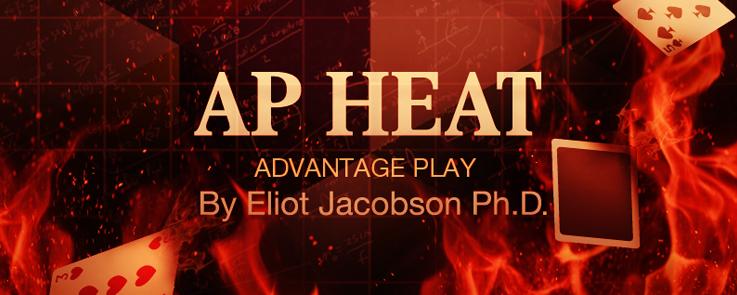Ultimate Texas Hold’em Hole-Card Play: One Dealer Card, One Turn/River Card

When an AP finds a dealer on Ultimate Texas Hold'em (UTH) who is vulnerable to hole-carding, it is not unusual for her to expose the bottom card of every packet of cards she delivers. This includes exposing one of her two hole-cards as well as one of the common cards. Depending on how the common cards are spread and turned over, the exposed common card will then either be a Flop card or it will be a Turn/River card. This post considers the situation when the AP sees one dealer hole-card and one Turn/River card. I previously wrote about the situation when the AP sees one dealer hole-card and one Flop card, where I showed that computer-perfect play gives an edge of 22.3286% (see this post).
Running a cycle for this program was massive. The total running time was about 11,580 minutes (just over 8 days). Along with computing the edge, the program output each starting hand together with the expected value for checking on the hand pre-Flop and for raising 4x pre-Flop.
I shortened the computation considerably by only considering equivalence classes of starting hands. This reduced the number of starting configurations from 3,248,700 to 187,213. For example, consider the starting hand Player = (2c, 7d), Dealer Hole-Card = 8h, River Hole-Card = Js. For convenience I will denote this as (2c, 7d), (8h), (Js). This hand is equivalent to both (2c, 7d), (8s), (Jh) as well as (2h, 7s), (8d), (Jc). Altogether, this hand is equivalent with 24 hands (including itself). I only needed to evaluate one of those 24 starting hands, and then multiply the result by 24, to get the total contribution of this one hand. The program also output the number of permutations for each starting hand, the "perms."
The following spreadsheet gives the full details for this computer analysis:
UTH_DHC_RHC (24 MB)
In particular,
-
The player edge in UTH knowing one dealer hole-card and one Turn/River hole-card is 26.1867%.
-
The player makes a 4x pre-Flop raise on 36.1368% of the hands.
-
The player checks pre-Flop on 63.8628% of the hands.
In Exhibit CAA, James Grosjean gives the AP an edge of 24.10% over the house using the practical strategy he provided. He does not list the edge of 26.1867% using computer-perfect play. As far as I know, this is the first time this number has been published. Then again, 24% is pretty good.
Here are some other facts about hole-carding UTH, knowing one dealer hole-card and one Turn/River card:
-
The best starting hand for the AP is player = (Kc, Kd), dealer = 2c, and Turn/River = Kh (and its permutations). The player should raise 4x in this situation, with EV = 6.1933.
-
The worst starting hand for the AP is player = (2c, 7d), dealer = Qd, and Turn/River = Qh (and its permutations). The player should check in this situation, with EV = -1.7265
-
The closest pre-Flop decision is when player = (8c, Ac), dealer = Kd and Turn/River = Th (and its permutations). In this case, checking pre-Flop has EV = -0.2505544 and raising 4x pre-Flop has EV = 0.2505537. The difference in EV between checking and raising 4x is 0.0007%.
I am not going to present a pre-Flop strategy. The reader is welcome to create his own by going through the spreadsheet I provided and creating some rules.
As far as game protection, I recommend that UTH be hand dealt, using the following procedure:
-
After removing the cards from the automatic shuffler, and after each player has made their Ante bet, a card is burned and two cards are dealt face-down to each player.
-
The players then look at their cards and make their pre-Flop check/raise decisions.
-
Another card is burned, then three Flop cards are dealt and turned face-up.
-
The players who have not yet raised then make their Flop check/raise decisions.
-
Another card is burned, then two Turn/River cards are dealt and turned face-up.
-
The players who have not yet raised then make their Turn/River raise/fold decisions.
-
Another card is burned, then two cards are dealt to the dealer and turned face-up.
-
All necessary cards have now been dealt, and the wagers can be resolved.
By avoiding dealing cards until those cards are necessary for the next wagering step in the game, there will be no hole-card opportunities. By burning the top card before cards are dealt, there will be no top-card (or marked-card) opportunities. I have observed that this dealing procedure is commonly used in Las Vegas.
For now, this is the last in my series of UTH posts. It would be reasonable to consider the cases when the AP does not see a dealer hole-card, but does catch either a Flop card or a Turn/River card. A sloppy dealer may, at times, not expose one of his own cards, while still exposing one of the common cards. If you're excited by the prospect of knowing the edge you can get in these cases, you'll just have to wait.


